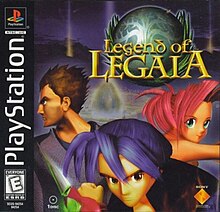

This article needs additional citations for verification. Please help improve this articlebyadding citations to reliable sources. Unsourced material may be challenged and removed.
Find sources: "Legend of Legaia" – news · newspapers · books · scholar · JSTOR (June 2011) (Learn how and when to remove this message) |
| Legend of Legaia | |
|---|---|

North American cover art
| |
| Developer(s) | Prokion Contrail (production) |
| Publisher(s) | Sony Computer Entertainment |
| Director(s) | Kazuhiro Kobayashi |
| Producer(s) | Takahiro Kaneko |
| Designer(s) | Natsumi Arisawa |
| Composer(s) | Michiru Ōshima |
| Platform(s) | PlayStation |
| Release |
|
| Genre(s) | Role-playing |
| Mode(s) | Single-player |
Legend of Legaia (レガイア伝説, Regaia Densetsu) is a turn-based role-playing video game. It is followed by Legaia 2: Duel Saga.
Legend of Legaia features a turn-based combat system. Rather than a simple "Attack" command, the player enters a sequence of strikes ("High," "Low," "Left," or "Right") and the character will perform the corresponding attacks. Certain sequences combine into special attacks called Arts—for example, the "High, Low, High" sequence allows Vahn to perform Somersault. The ending of one sequence can be linked to the beginning of another to perform multiple Arts. Regular attacks restore AP, while Arts cost AP. Additionally, characters can summon Seru at the cost of MP, use items, and use the Spirit command which restores AP, bolsters defense, and allows for a longer attack sequence next turn.[2]
The game is set in a fantasy world, where humanity exists along strange magical creatures called Seru who aid humanity with supernatural powers. However, a mysterious Mist appears and the Seru become rampant, causing the collapse of civilization. Vahn, the resident of Rim Elm, is unaffected by the Mist outside and protected from Seru by a large wall. An enormous Seru, Juggernaut, destroys the wall and corrupts the Seru. Vahn discovers a rare kind of Seru known as a Ra-Seru named Meta, which is both intelligent and capable of merging with a human. He awakens the power of the tree in the center of the village known as a Genesis Tree, and removes the Mist and the Seru from the village. With his newfound power, he travels across the world to restore Genesis Trees and stop the Mist.
Vahn continues his journey to awaken the Genesis trees and befriends Noa, a cavegirl raised by a Ra-Seru attached to a wolf which eventually attaches itself to her. Vahn meets Gala, a monk who after finding a dead genesis tree finds a Ra-Seru egg and at another genesis tree births the Ra-Seru egg that bonds with Gala. The trio destroys the mist generator in their continent. They move to another continent and reawaken the Genesis Trees, destroy the mist generator and its defender, and come across the Juggernaut's castle. It is revealed the mist is created with Ra-Seru which is why the Ra-Seru are immune to the mist.
The three heroes reach the final continent and encounter several mist generators and Cort, the prince of a kingdom and Noa's brother. After destroying the mist generators and defeating Cort, the heroes return to Vahn's village, where Cort has fused with Juggernaut, and threatens to kill everyone and destroy the village.
The three heroes learn that Gala's rival Songi went to the land of Ra-Seru and is attempting to absorb and in effect kill the mother Genesis Tree. They arrive and defeat Songi, but are unable to save the mother Genesis Tree, and when it dies, so will all Seru. The heroes then go to Vahn's village and defeat the fused combination of Cort and Juggernaut. After Cort's defeat, the Ra-Seru bid farewell and die with the Seru, leaving humans to fend for themselves.
| Aggregator | Score |
|---|---|
| GameRankings | 77%[3] |
| Publication | Score |
|---|---|
| AllGame | |
| CNET Gamecenter | 8/10[5] |
| Electronic Gaming Monthly | 7.875/10[6] |
| Famitsu | 27/40[7] |
| Game Informer | 8.25/10[8] |
| GameFan | 81%[9] |
| GamePro | |
| GameRevolution | C[11] |
| GameSpot | 7.3/10[12] |
| IGN | 7/10[2] |
| Next Generation | |
| Official U.S. PlayStation Magazine | |
| RPGamer | (2004) 8.5/10[15] (2013) 3.5/5[16] |
| RPGFan | 80%[17] |
| Common Sense Media |
The game received favorable reviews on GameRankings. Next Generation said, "if you can deal with the trite, hackneyed story, the new fighting engine makes this worth checking out." Famitsu scored it 27 out of 40. It sold over 300,000 units by January 2002.[19]
During the 3rd Annual Interactive Achievement Awards, the Academy of Interactive Arts & Sciences nominated Legend of Legaia for "Console Adventure/Role-Playing Game of the Year".[20]
| Authority control databases: National |
|
|---|